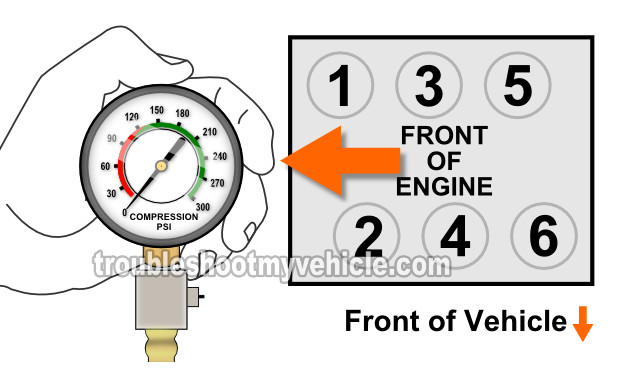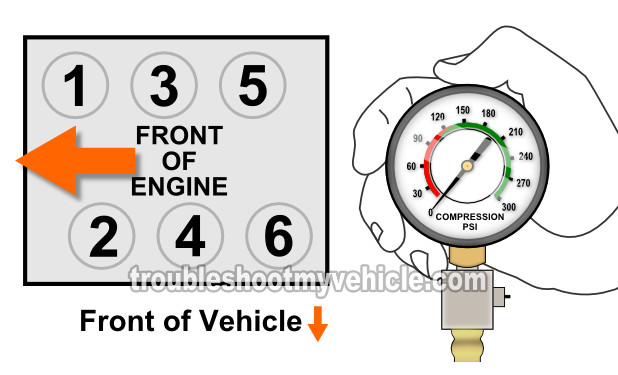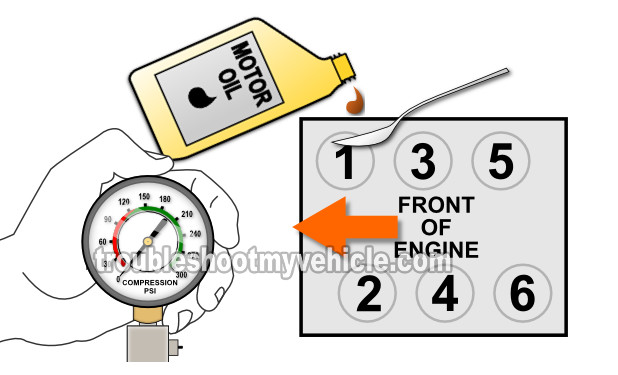
An engine compression test can give you a wealth of information about the internal health of the engine.
But beyond that, it can also let you know if an engine compression problem is causing a driveability or engine performance problem.
In this tutorial, I'll explain how to do an engine compression test and more importantly, how to interpret your test results.
You'll be able to easily find out whether an engine compression problem is causing an engine performance issue or not.
Contents of this tutorial:
APPLIES TO: This tutorial applies to the following vehicles:
- 3.4L V6 Buick Rendezvous: 2002, 2003, 2004, 2005.
- 3.4L V6 Oldsmobile Alero: 1999, 2000, 2001, 2002, 2003, 2004.
- 3.4L V6 Oldsmobile Silhouette: 1996, 1997, 1998, 1999, 2000, 2001, 2002, 2003, 2004.
Symptoms Of Low Or No Engine Compression
It's been my experience, working as an automotive technician over the years, that engine compression problems usually cause one of two things:
- The engine compression problem will cause an engine no-start problem.
- -or-
- The engine compression problem will allow the engine to start and run, but it'll run with a misfire condition.
If the engine starts and runs, but is suffering and engine compression problem, you'll see one or more of the following:
- Bad gas mileage.
- A heavier exhaust smell coming out of its tailpipe.
- Engine is not as peppy as it was once.
- Rough idle that goes away as soon as you accelerate the engine.
- One or more of the following misfire trouble codes:
- P0300: Random Cylinder Misfire.
- P0301: Cylinder #1 Misfire.
- P0302: Cylinder #2 Misfire.
- P0303: Cylinder #3 Misfire.
- P0304: Cylinder #4 Misfire.
- P0305: Cylinder #5 Misfire.
- P0306: Cylinder #6 Misfire.
Which Compression Tester Should I Buy?
There are lot of engine compression testers to choose from and many places to buy them. I'm gonna' make some recommendations to you:
Disclosure: As an Amazon Associate, I earn from qualifying purchases. If my tutorials help you, using these links is an easy way to support the site at no extra cost to you. Thank you!
TEST 1: 'Dry' Engine Compression Test

Before you remove the spark plugs, it's important that you label each spark plug wire with the cylinder number it belongs to. Otherwise, you'll lose the spark plug wires' firing order and you're going to have an engine no-start problem on your hands.
If you don't have a compression tester, you can always run down to your local auto parts store (AutoZone, O'Reilly Auto Parts) and borrow one from them.
They'll ask you for a small deposit that they'll return to you once you return the tool. Now if you're interested in buying your own compression tester and saving a few bucks in the process, then take a look at my recommendations here: Which Compression Tester Should I Buy?
IMPORTANT: Do not remove the spark plugs if the engine is hot. If the engine has been running for any amount of time, let it cool down completely before removing the spark plugs.
CAUTION: Take all necessary safety precautions. The engine has to be cranked to perform the engine compression test. Be careful and think safety all the time!
Okay, these are the test steps:
- 1
Disable the fuel system by removing the fuel pump relay.
This will prevent fuel from being injected into the cylinders as you crank the engine. - 2
Disable the ignition system by disconnecting the ignition coil from its electrical connector.
Don't overlook this step, since disabling the ignition system will prevent the ignition coil from firing spark during the test. - 3
Disconnect all spark plug wires from the spark plugs and remove all spark plugs.
I recommend labeling the spark plug wires before removing them so you'll know where they go when you put them back on.
As you' re taking them out, be careful and don't drop any of them on the floor, or you could cause the spark plug's ceramic insulator to break, and this will cause a misfire! - 4
Thread the engine compression gauge into the spark plug hole for the number 1 engine cylinder (this is the spark plug hole closest to the drive belt).
IMPORTANT: Hand tighten the compression gauge only! Do not use any type of tool to get it tight. - 5
When the tester is set up, ask your helper to crank the engine. Your job is to keep your eye on the compression tester's gauge.
- 6
Once the needle on the gauge stops climbing, have your helper stop cranking the engine.
- 7
Write down the compression value on a piece of paper.
Include the number of the cylinder this reading belongs to. - 8
Repeat steps 3 thru' 7 on the remaining cylinders.
Let's take a look at what your test results mean:
CASE 1: Low or no compression in 2 or all cylinders. This test result indicates a serious internal problem.
The most common issues would be:
- Blown head gasket.
- Broken timing chain or timing gear.
- Engine threw a rod.
CASE 2: Low compression in one or more cylinders. Up to a certain point, it's normal for the compression to vary a little between cylinders (as the engine accumulates thousands of miles).
But if these values vary too much, then you're gonna' have a bonafide misfire on your hands.
The next step is to do some math to find out if this low compression value is within a normal parameter or not. Go to: Interpreting Your Compression Test Results.
Interpreting Your Compression Test Results
If you're reading this section, then your compression test results indicate that one or more cylinders are producing a low compression value.
If the low compression value is within a certain range, the engine won't notice a thing and neither will you as you drive up and down the road.
But if the low compression values are greater than the specified range, the engine will suffer engine performance and driveability issues.
How do we find out if the low compression values are causing a problem? To find out, we need to figure out if the low compression values are lower than 15% of the highest compression value you got.
You can do this (figuring out the 15%) in one of two ways: You can calculate this 15% difference with pen and paper or you can use my low compression calculator. You can find the low compression calculator here: Online Low Engine Compression Calculator (at: easyautodiagnostics.com).
If you want to manually calculate the 15% difference, here's what you'll need to do:
- STEP 1: Multiply the highest compression value by 0.15 (this is the decimal value of 15%).
- STEP 2: Round the result to the nearest one (for example: 25.6 would become 26).
- STEP 3: Subtract the result (the number that was rounded) from the highest compression value.
- ANSWER: The result of this subtraction is the lowest possible compression value any cylinder can have.
Now, let me give you a more specific example: Let's say that I got the following compression readings:
| Cylinder | Pressure |
|---|---|
| #1 | 165 PSI |
| #2 | 95 PSI |
| #3 | 155 PSI |
| #4 | 175 PSI |
| #5 | 175 PSI |
| #6 | 170 PSI |
My next step is to do the following calculation:
- STEP 1: 175 x 0.15 = 26.25.
- STEP 2: 26.25 = 26 (rounded to nearest one).
- STEP 3: 175 - 26 = 149.
- ANSWER: 149 PSI. Any cylinder with this compression (or lower) value will misfire.
Since cylinder #2 is only producing 95 PSI, I can now conclude that it's 'dead' and causing a misfire.
To find out if the lowest compression value you got from your engine compression test is within a good range, you'll need to do the same calculation. Of course, you'll need to use the highest compression value you got and not the one in the example.
Once you've found the 'dead' cylinder, the next step is to find out what's causing the low compression value. For this step, go to: TEST 2: 'Wet' Engine Compression Test.
TEST 2: 'Wet' Engine Compression Test

A low compression value is usually caused by the affected cylinder or cylinders having worn piston rings or worn cylinder head valves.
The cool thing is, that we don't need to tear the engine apart to visually inspect these components. We can find out where the problem lies by doing a simple wet compression test.
This test simply involves adding a small amount of engine oil to the cylinder with low compression and testing its compression again.
If its compression value increases, from the value you got in TEST 1, then you can conclude that the problem causing the low compression value is due to that cylinder's piston rings.
If the compression value does not increase, after adding oil to the cylinder and retesting is compression, then you now know for certain that its intake/exhaust valves have a problem.
Alright, let's get going:
- 1
Add a small amount of engine oil to the cylinder that reported low compression or no compression in the 'dry' compression test.
You don't have to add a lot of oil. The amount should be about 1 to 2 tablespoons of oil. - 2
Install the compression tester onto the cylinder.
Do not use any type of tool to tighten the compression tester. Hand tight is fine. - 3
When all is set up, have your helper crank the engine.
- 4
You'll get one of two results:
1.) The compression value will go up (from the one you recorded before).
2.) The compression value will stay the same.
Let's take a look at what your test results mean:
CASE 1: The compression value shot up. This tells you that the piston compression rings are worn out and thus the problem is in the bottom end (block) of the engine in your 3.4L V6 Buick (Oldsmobile).
CASE 2: The compression value stayed the same. This confirms that the low compression problem of the affected cylinder is due to worn or damaged cylinder head valves.
More 3.4L V6 Buick, Oldsmobile Tutorials
You can find a complete list of 3.4L V6 Buick (Oldsmobile) tutorials in this index:
Here's a small sample of the tutorials you'll find in the index:
- What Do The Spark Plugs Do? (3.4L V6 Buick, Oldsmobile).
- How To Test The MAF Sensor (3.4L V6 Buick, Oldsmobile).
- What Does The CKP Sensor Do? (3.4L V6 Buick, Oldsmobile).
- How To Test The Throttle Position Sensor (3.4L V6 Buick, Oldsmobile).

If this info saved the day, buy me a beer!





